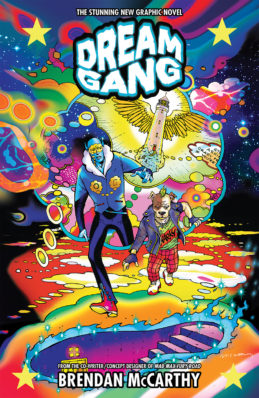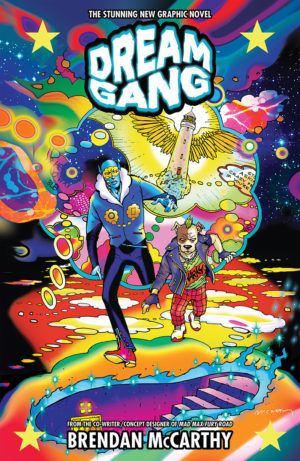
 Occasionally, for your third eye to become unhinged, your other two have to remain sealed shut; dreams provide a canvas for creativity to reign free, and repressed ideas and memories to manifest into bizarre concoctions only limited by your imagination.
Occasionally, for your third eye to become unhinged, your other two have to remain sealed shut; dreams provide a canvas for creativity to reign free, and repressed ideas and memories to manifest into bizarre concoctions only limited by your imagination.
Brendan McCarthy, coming hot off the success of Mad Max: Fury Road, which he provided the concept art for and co-wrote, returns to the comic book space and explores the dream-scape with his newest graphic novel, Dream Gang.
Arts and Crafts
Dream Gang, as you guessed it, takes place within Patrick’s—the protagonist of the story—dream. McCarthy uses the setting to his advantage, as he liberally paints each scene with vivid neon colors reminiscent of Grateful Dead poster art. Each panel– even the ones devoid of color– pop off the page. The line art has an intentional shaky style that contrasts well with the psychedelic coloring. It evokes the hand drawn look of comics from the ’80s, before computers and tablets gave everything a pristine shine.
McCarthy does falter a bit, showing some inconsistency across the graphic novel. His strength is clearly in character close ups, as each individual is clearly defined and detailed. It’s during large-scale events that depict multiple characters from a smaller perspective that things start to become muddy; characters become warped and their poses start to look unnatural.
The most unfortunate thing about the artwork in Dream Gang is the inclusion of real world photographs that are scattered within the backgrounds. Most of the time they are used as textures to, perhaps, give the scenes more depth, and other times they are the main focus of the scene. It just doesn’t work and is obnoxiously jarring—completely immersion breaking.
Bed-Time Story
Despite being set within a dream, where the possibilities for unique imagery and story setups are endless, McCarthy wisely uses the setting to express a very personal and grounded tale. Dream Gang gives us a glimpse of Patrick’s monotonous life before jumping into the worlds within his dream; he’s thrust into a power struggle between Zeririo and the Dream Gang. Zeririo, the antagonist of the story, wants to transcend into reality from the dream world, which is promised to him by nightmare entities in exchange for an innocent mindscape, who happens to be Patrick’s best friend in the form of a repressed memory. Patrick, now bestowed the title of Dream Voyager, is tasked with taking him down and rounding up the rest of the Dream Gang.
At times, it all seems unnecessarily bloated, as Dream Gang goes out its way to complicate what is, at its core, a simple story about reconciliation. McCarthy constantly throws foreign terms and titles of items/objects are relentlessly thrown at the reader, making it difficult to absorb their true meanings. If this was a series it wouldn’t be a problem, but as a self-contained story, it can come ass problematic as it muddles the story.
Final Thoughts
From the first few pages of Dream Gang, it’s evident that this was a personal story that McCarthy wanted to tell. He was clearly having fun with what seemed like a return to form— from the colors to the organic line art, there’s a liveliness to it all. Dream Gang would have benefited greatly from an editor, as it spirals out of control and becomes hard to follow half-way through. Besides the few missteps, it’s satisfactory for a quick light read, but a hard sell for anyone looking for something with substance.

Leave a Reply